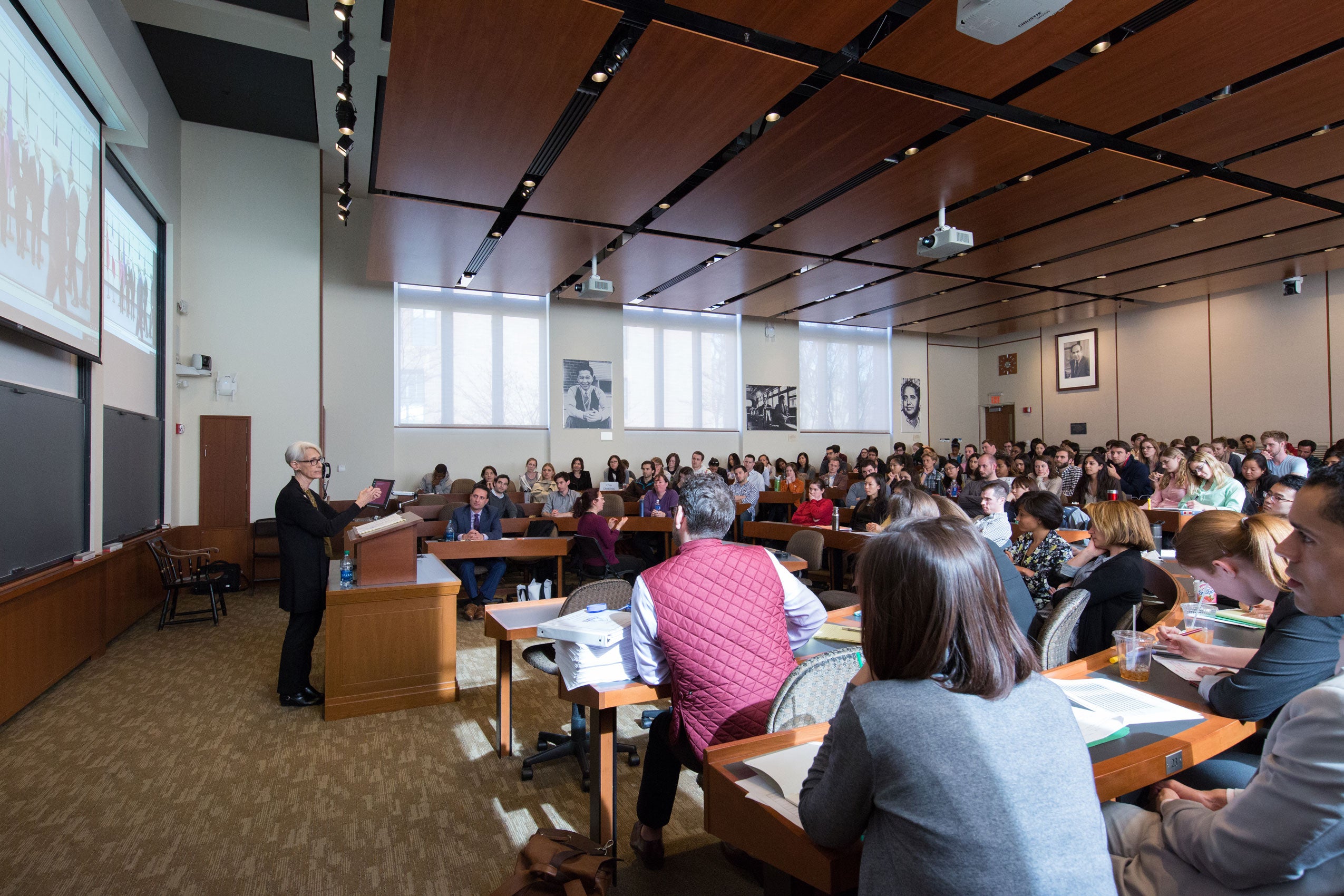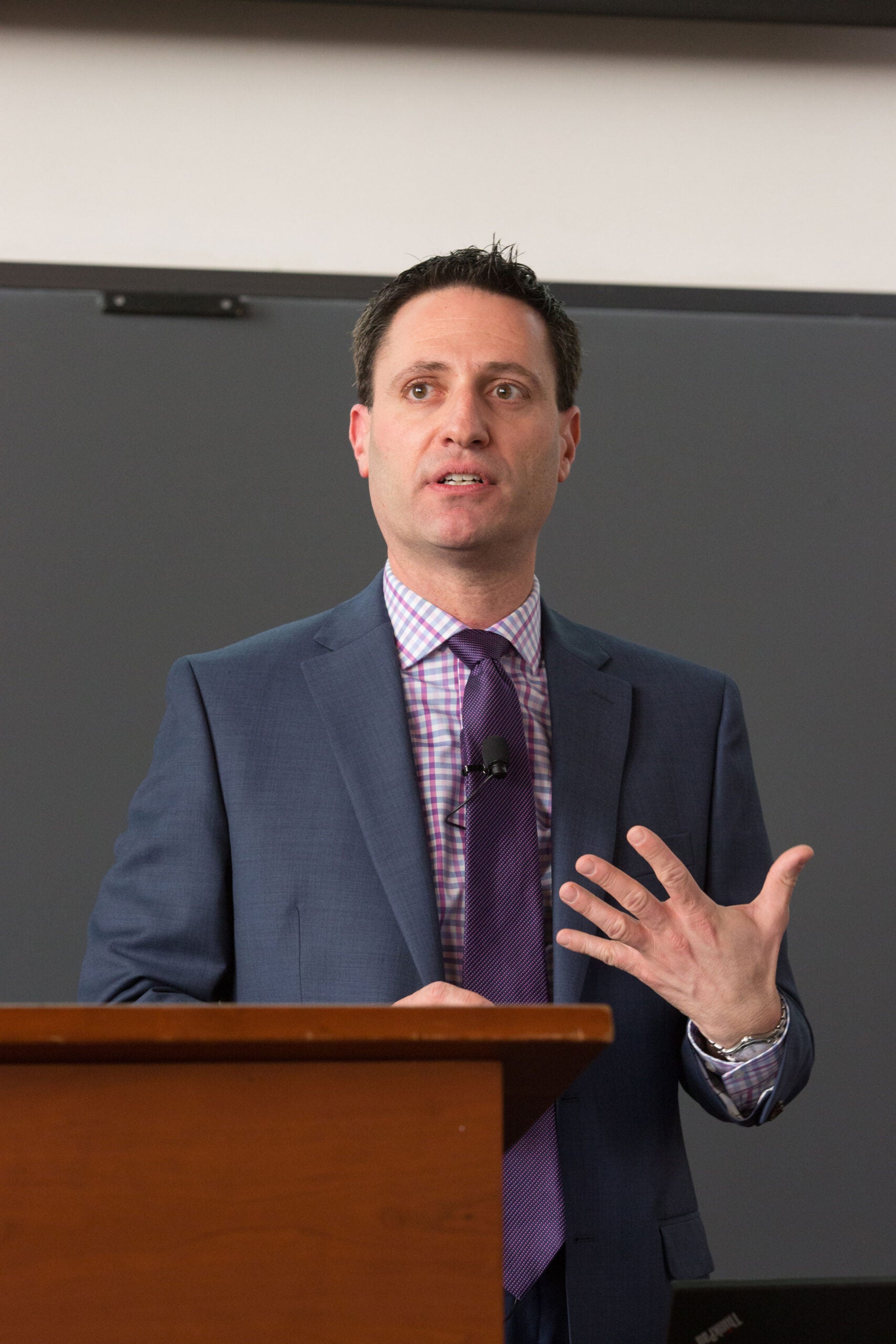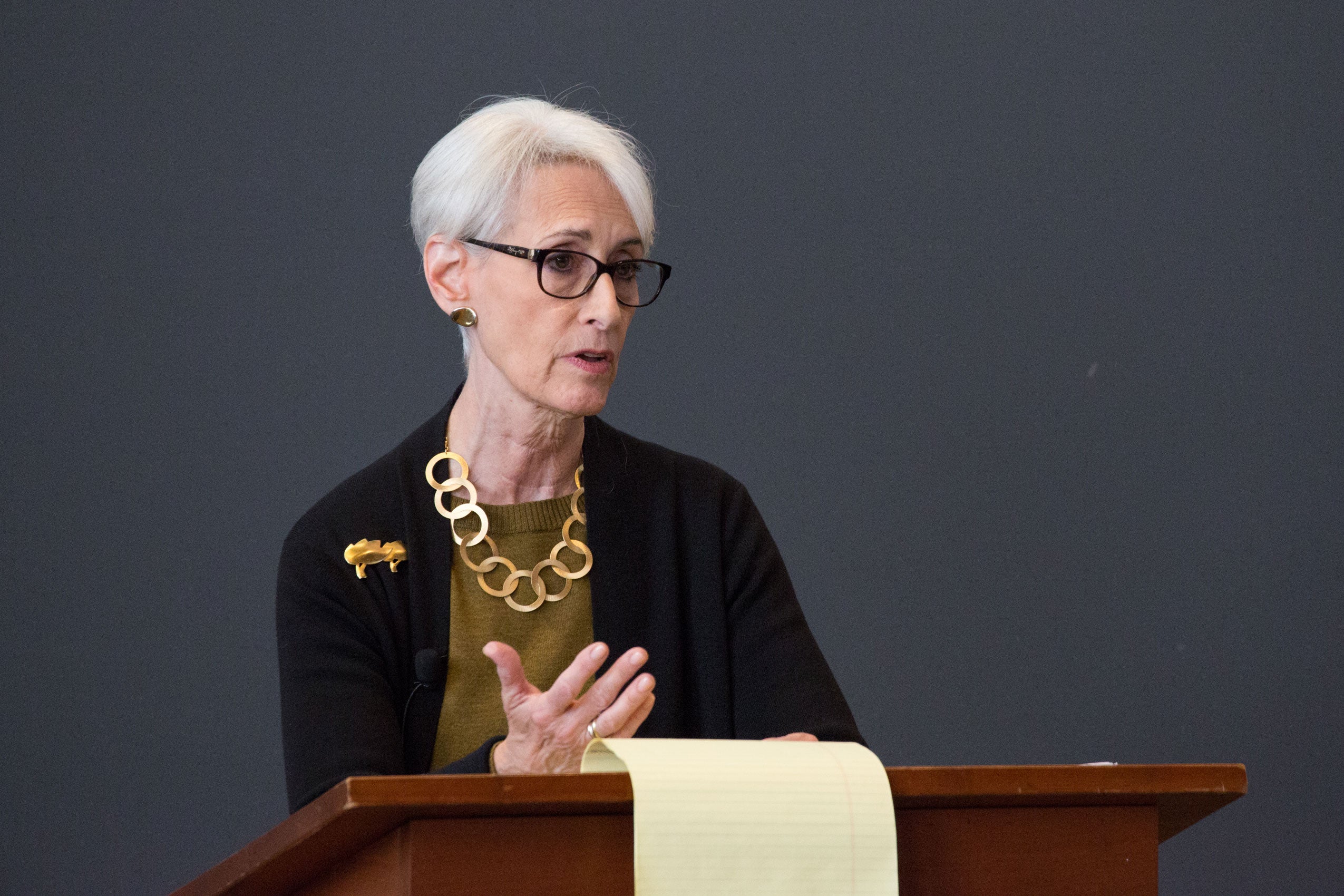When Wendy Sherman, former under secretary of state for political affairs, was in the midst of negotiations over Iran’s nuclear program, she often felt that her team was playing “several games of multidimensional chess at the same time.”
On April 20, Sherman delivered a guest lecture to the Harvard Law School Negotiation Workshop. In welcoming Sherman to Harvard Law School, Clinical Professor Robert Bordone ’97 said that Sherman’s accomplishments at the State Department represent “the very best in American diplomacy.” “Ambassador Sherman’s service to the nation – advancing peace and security for the United States and the world community – demonstrate the power of creativity, tenacity, effective assertion, and critical perspective-taking that are at the heart of what we aspire to teach in the Negotiation Workshop here at the Law School,” he said.

Sherman’s remarks focused on her time as the lead U.S. negotiator of the Joint Comprehensive Plan of Action (JCPOA). Her experience offered a fascinating window into the inner workings of what happened at the negotiating table in this complex international negotiation.
Sherman shared the long history of political, military, and economic tensions that have ebbed and flowed between Iran and the international community since the 1950s, when Iran first established its nuclear program. At its outset, the Iranian nuclear program was intended for peaceful purposes. However, over time, she said, the United States, and much of the international community, came to suspect that the program had evolved to include the development of nuclear weapons. Anxiety about Iran’s nuclear program – along with Iran’s destabilizing action in the region, its involvement in state-sponsored terrorism, and other sources of concern – contributed to the United States’ distrust of Iran. In turn, Iran grew distrustful of the United States as a result of the heavy economic sanctions that the United States, and others, imposed in recent years and the potential for U.S. military action.

While the sanctions never halted Iran’s nuclear program, they did, in Sherman’s words, “help bring Iran to the negotiating table.” By the time Sherman joined the U.S. negotiating team in 2011, President Barack Obama had examined the alternatives to negotiation and decided that they were unattractive: Further economic sanctions would likely be unenforceable and could hurt the global economy, and military action – though it would temporarily wipe out the nuclear facilities – could not “bomb away knowledge,” Sherman said. As a result, Obama came to the critical decision that he might potentially consider a very limited, civil, and peaceful enrichment program in Iran, if Iran submitted to vigorous and tough monitoring and verification measures.
With this broad guidance in mind, Sherman and her team of experts went to work for the next two and a half years, with the P5+1 (UK, France, Russia, China, Germany and the U.S.) and the European Union, developing an agreement that would ensure that Iran would never be able to obtain a nuclear weapon. In return for extensive monitoring of an extremely limited nuclear program to ensure that it remained peaceful, the United States, and others, would lift some sanctions on Iran in order to allow its economy to grow.
Some measures along the way seemed successful, such as the diplomatic negotiations – held outside the public view – between the United States and Iran facilitated by leaders from Oman. These talks resulted in the Joint Plan of Action (JPOA), a set of interim steps and a roadmap for further negotiations, agreed by the P5+1, the EU and Iran. Although not designed to be a confidence-building measure, the JPOA acted as one after being presented to the P5+1 and enduring through several more rounds of talks.
Many issues and parties raised the level of complexity of the negotiations – hence the simultaneous games of chess. From the governments in the P5+1 and the EU to Iran’s regional neighbors, the United States Congress, and other powerful figures and forces within Iran, a tremendous number of parties had a stake in the outcome of the deal. The elements of the negotiations themselves posed a challenge, as well: “Reaching a consensus on the technical issues,” Sherman recalled, “was a Rubik’s cube.” Experts held seminars for one another on sanctions, transparency measures, and even the science behind enriching uranium – and these technical issues were on the table at the same time as the political questions that needed to be resolved. In navigating this complex terrain, the parties consistently tried to find the best devices to move the negotiation forward. For instance, when the Iranian delegation was not yet ready to put agreement terms on paper, she used a whiteboard “to test ideas” before committing to items.
In the end, Sherman believes that the major success of the talks was the achievement of coming to an agreement about such a contentious issue, despite years of distrust between Iran and the United States and its partners. She was quick to add that “the devil is in the details”: Now that the implementation stage has begun, there are sure to be further issues to iron out as the terms of the agreement are enacted, and much distrust remains between the two countries. But in reflecting on her overall experience, Sherman highlighted ten key insights and lessons about negotiation that she shared with Workshop students, echoing many of the themes from the course:
- There was a clear objective: Clarity and communication from top U.S. leaders enabled the team to identify areas of flexibility;
- Despite outside pressure, the team’s focus remained in the negotiating room;
- The political will existed amongst all parties to get the deal done;
- The team understood all parties’ interests;
- Timing was everything: The parties understood the alternatives to negotiation, and none was attractive;
- All parties had leverage in different ways;
- All parties had stamina;
- The US delegation had excellent intelligence, communication, and a team of experts with whom to consult;
- For the US, the negotiations were never about trust alone; they were about verification and monitoring;
- Everyone compromised some, but no one conceded everything, with one major exception: Iran would never be allowed to obtain a nuclear weapon.
In concluding her session with Workshop students, Sherman touched on potential applications of her work to other unstable areas around the world, including Syria and North Korea. While these situations pose their own unique challenges, Sherman is confident that the progress made by negotiating the JCPOA with Iran was an important step toward a more peaceful world. It was remarkable, she said, to support “the promise of peace in the fog of war.”
Following her formal remarks, Sherman answered questions from Negotiation Workshop students for nearly 45 minutes. In thanking Sherman for speaking to his class, Bordone noted, “In the span of 90 minutes you have ably summarized the key themes of this course, demonstrated their applicability in the real world, and inspired us all by your wisdom, humor, and humility.”
Ambassador Sherman’s visit to the Spring Negotiation Workshop is the latest installment in an annual feature of the course in which a prominent real-life negotiator speaks to enrolled students about their professional negotiation experience in an area of practice. Past speakers have included Bob Barnett, Ron Shapiro, Rose Gottemoeller, Grande Lum, and Clifford Sloan. The Negotiation Workshop is offered each January term and spring, and combines theory and practice to improve students’ understanding of negotiation and their skills as negotiators.
This article was written by Sara del Nido Budish, Clinical Fellow at the Harvard Negotiation & Mediation Clinical Program.
